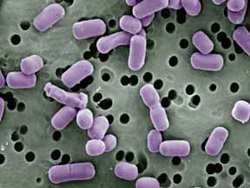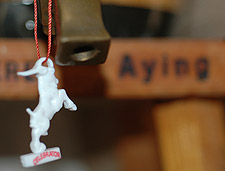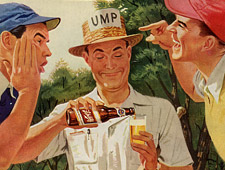Brewers across the nation will be cringing when they read the investigative report in today’s Milwaukee Journal Sentinel about dirty beer lines.
Of course this a local story, even quoting a vendor that “Milwaukee is a real horrible town for draft beer.”
 But this will have repercussions in craft beer land because the “dirtiest” beer the reporters found came from a brewpub and the second dirtiest was another “microbrewed” beer. Both contained large amounts of lactobacillus (left), bacteria that produces lactic acid, souring a beer’s flavors and smells. It is the same microorganism responsible for spoiling milk.
But this will have repercussions in craft beer land because the “dirtiest” beer the reporters found came from a brewpub and the second dirtiest was another “microbrewed” beer. Both contained large amounts of lactobacillus (left), bacteria that produces lactic acid, souring a beer’s flavors and smells. It is the same microorganism responsible for spoiling milk.
So does that mean you should be concerned about the beer on tap at your local brewpub? Or that small breweries aren’t able to control quality – clear through to what is poured into your glass at a bar – as well as large?
First, this isn’t a safety issue but a quality one. Trust your senses, and if you notice foul aromas or sour beer point it out to your server. Second, a Budweiser checked at a place called Chasers Pub contained 1,950 cells of lactobacillus per gram and a yeast count of 16,400 cells per gram (sounds like a lot, doesn’t it?).
That’s not to say that breweries don’t recognize they’ve got a problem. In delivering the keynote speech at this year’s Craft Brewers Conference, Vinnie Cilurzo of Russian River Brewing said: “The integrity and quality of our beer is more important than hitting a certain growth number each year. Making sure the consumer is purchasing fresh craft beer is just one example. Taking care of draft lines and cleaning them properly is yet another example of the integrity I speak of.”
Boulevard Brewing founder John McDonald has been and an industry leader in addressing the problem and outspoken on the topic. “It depresses me how deplorable the state of draft lines has become,” he said a few years ago.
You might say the Brewers Association is taking the Journal Sentinel story head on – posting two stories about draft quality on the front page of its website and issuing a press release for an upcoming manual to improve draft quality (obviously in the works well before the Milwaukee investigation).
A Draft Quality Standards Committee comprised of small, large, and foreign brewers is in place and slated to release a standards manual in the first quarter of 2008. This document will be available to distributors, retailers, and the public. The goal will be to produce a comprehensive manual addressing draft beer dispensing and serving.
Let’s be straight. Addressing the problem is not the same as solving the problem. Dirty lines are always going to be a danger, and while we appreciate it when brewers choose not to filter out flavor those unfiltered beers also leave more sediment in lines. A dozen years ago a vendor told me the dirtiest lines he came across were always in brewpubs because it was distributors who trained bars and restaurants to clean lines (and most brewpubs didn’t buy draft beer from distributors).
But there’s reason to be optimistic. Everybody agrees that clean lines are good business. “I have never heard a bar customer say, ‘Gee, this bar does a lousy job of maintaining and cleaning their lines,’” New Belgium Brewing co-founder Kim Jordan once said. “They say that the beer they ordered is lousy.”
And then there is the matter of pride. The Journal Sentinel reported that New Glarus Brewing brewmaster Dan Carey takes it personally when one of his beers is served through a dirty line at a bar.
“It ruins my evening,” Cary told a reporter. “It’s my baby, and damn it, you’ve ruined it.”
 Fall is in the air. The mornings are crisper, roll down your window as you pass the Fruit Basket on Fourth Street and you can smell green chiles roasting, RVs are already parked around Balloon Fiesta Park . . . and the Men’s Journal fourth annual guide to “The World’s Best Beers” is out.
Fall is in the air. The mornings are crisper, roll down your window as you pass the Fruit Basket on Fourth Street and you can smell green chiles roasting, RVs are already parked around Balloon Fiesta Park . . . and the Men’s Journal fourth annual guide to “The World’s Best Beers” is out. But this will have repercussions in craft beer land because the “dirtiest” beer the reporters found came from a brewpub and the second dirtiest was another “microbrewed” beer. Both contained large amounts of lactobacillus (left), bacteria that produces lactic acid, souring a beer’s flavors and smells. It is the same microorganism responsible for spoiling milk.
But this will have repercussions in craft beer land because the “dirtiest” beer the reporters found came from a brewpub and the second dirtiest was another “microbrewed” beer. Both contained large amounts of lactobacillus (left), bacteria that produces lactic acid, souring a beer’s flavors and smells. It is the same microorganism responsible for spoiling milk. And the latest advertising for Miller Lite introduces something called the
And the latest advertising for Miller Lite introduces something called the